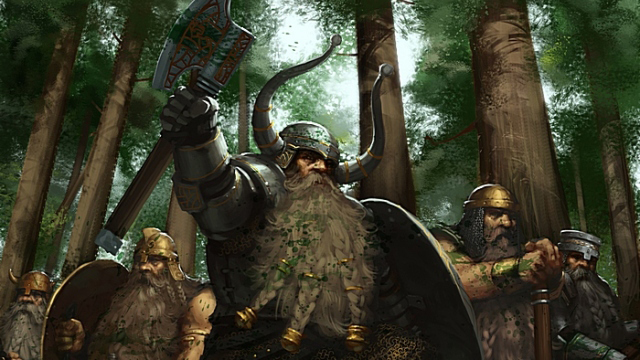
Warhammer is definitely one of the most detailed and well thought out fictional universes out there. Every branch of both Warhammer Fantasy and Warhammer 40K has been scrupulously planned out by a whole army of the industry's finest writers and designers.
Many of you may not be aware of some of the facts that play a huge role in the life of Warhammer universe due to the overwhelming amount of materials. For this reason, we present you with some of the biggest and most surprising facts from the world of Warhammer that every fan should know about.

Warhammer Fantasy and Warhammer 40K once shared the same world
In the early stages of development, these two worlds shared the same history and setting. Warhammer 40K was simply the futuristic version, a continuation of the Warhammer Fantasy’s saga. Only years later did Games Workshop decide to separate the two universes, which is why today most fans consider them to be completely different.
For example, it is considered that the Warhammer 40K universe began on Terra – a planet just like our Earth, but the world of Warhammer Fantasy was something else. Now, early scripts cite that it was actually the same world, which was later terraformed by the beings known as the Old Ones.
So, this explains why both of these universes share so much in common, but at the same time have traditions of their own.

Sigmar Heldenhammer is Conan the Barbarian
It is no surprise that Warhammer Fantasy is based on the real history of humanity and the combination of several other fictional universes. If you are more or less familiar with the chronicles of Warhammer Fantasy, then you will notice how much they resemble certain elements from other well-known stories.
One such similarity can traced down in the Sigmar Heldenhammer's lore, the god-emperor of mankind, the son of Bjorn Unberogen, the chief of the Unberogen tribe -- who was born on the battlefield, and whose mother died right after she gave birth to him. In exactly the same way Conan the Barbarian, another famous fictional character, was born in Cimmeria during the battle of barbarians.
The similarity of these two characters is striking and probably not incidental at all.

Warp is not the same as Warpstone
Warp and Warpstone play huge roles in both Warhammer Fantasy and Warhammer 40K universes. However, these two notions are vastly different, although they do share the same origin, which is the Realm of Chaos.
In Warhammer 40K, Warp is a dimension of magic energy that allows spaceships to activate their engines and travel to distant areas of the universe. This area of space is inhabited by Dark Gods and their demonic servants, which also serves as the origin of all life in the universe.
On the other hand, in Warhammer Fantasy, Warpstones, although considered to be the solidification of the energy of Chaos, are used for completely different purposes and have nothing to do with space travel. These precious crystals are used to create weapons and give them special attributes.

Dwarfs are strongly influenced by Viking culture
Besides a strong visual resemblance of long beards, horned helmets and characteristic armor sets, Dwarfs in Warhammer Fantasy have lots of other, much smaller details that are strongly influenced by the culture of Vikings.
For example, Dwarfs in Warhammer Fantasy never use last names, only the first ones and the names of their fathers, if they need to distinguish one representative of the race from another. Nordic warriors had the same custom and never used last names.
Also, Dwarfs are known to be extremely violent to other races and can cause a battle even for the smallest reasons. Due to their constant need to fight and use their huge pool of weapons and armor, Dwarfs are considered one of the most dangerous tribes in the Warhammer universe -- just like Vikings were throughout their historical existence.

Waaagh! never changes
The principle of “Waaagh!” is heavily used by the Greenskins in both Warhammer Fantasy and Warhammer 40K universes.
In Warhammer Fantasy, this guttural cry prompts all the Orks and Goblins to unite for one sole purpose -- to battle against a common foe. However, even if there is no enemy to fight, the Greenskins gladly wield wars against each other.
In Warhammer 40K, “Waaagh!” carries an even bigger meaning – this is how Orks call their entire military campaigns, which are regularly held to satisfy an infinite hunger of the Greenskins for violence and destruction.
"Waagh!" is just like "war," and it never changes.

Vampires can wage battles during the daytime
Vampires in Warhammer are generally considered a weaker race than Dwarfs or Orks. They are vulnerable to all sorts of things, especially daylight. Some of the higher Vampire Counts are, of course, strong and can survive anything, although will lose a massive amount of their powers.
However, despite all these shortcomings, Vampires have a way out and can fight and win during daytime, as well. So, how do they do it?
The higher Vampires can cast dark clouds in the sky as thick as the night itself, and this allows their armies to use their full potential at any time of the day without being exposed to the odious sunlight.

Dark Elves incidentally destroyed their own homeland
In the early days of Warhammer Fantasy, Malekith, the King of the Dark Elves, ordered his sorcerers to undo the Vortex of Ulthuan – a passage between their world and the malevolent forces of Chaos. As a result, the powerful magic completely destroyed the basis of the entire Ulthuan – the homeland of elves.
The cataclysm that shattered the land of elves and killed thousands of its representatives later became known as “The Sundering.” Eventually the magicians managed to keep afloat several fortresses, which are now known as "Black Arks" floating in the dark seas of Naggaroth – the new home of the Dark Elves.
Now, with all the necessary knowledge of the Warhammer lore, you can play the first game of the planned Total War: Warhammer trilogy released on May 24, 2016.
Which other great facts from the Warhammer universe you know about? Let us know in the comments section!






Published: Jun 3, 2016 10:54 am